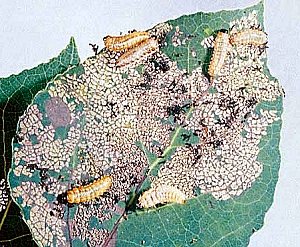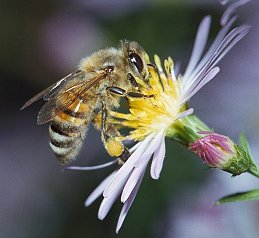Insect Herbivores
 Animals that feed on plant tissues or plant products are often called herbivores. This term applies not only to insects that injure a plant by chewing leaves or sucking sap but also to more benign species who only collect pollen, nectar, or plant resins. Entomologists frequently use the noun “phytophagy” and the adjective “phytophagous” when referring to any of these nutritional strategies. Both words are derived from Greek roots: “phyton” meaning plant and “phagein” the verb to eat or devour.
Animals that feed on plant tissues or plant products are often called herbivores. This term applies not only to insects that injure a plant by chewing leaves or sucking sap but also to more benign species who only collect pollen, nectar, or plant resins. Entomologists frequently use the noun “phytophagy” and the adjective “phytophagous” when referring to any of these nutritional strategies. Both words are derived from Greek roots: “phyton” meaning plant and “phagein” the verb to eat or devour.
Phytophagous insects generally use visual or olfactory (odor) cues to locate a host plant. Visual cues may be as simple as the vertical silhouette of a tree or the contrast of white flowers against a dark background of foliage. Some insects are strongly attracted to certain shapes or colors which they evidently associate with “food”. Red spheres, for example, attract adult apple maggots, white pans of water attract aphids, and bright yellow sticky traps attract leafhoppers. Odor cues are plant volatiles such as the saponins in alfalfa, the mustard oils in crucifers, or the terpenes in conifers. Sometimes these attractants are primary plant compounds such as sugars (e.g. glucose), nucleotides (e.g. adenine), or amino acids (e.g. alanine) that a plant needs for its own survival and growth. But in other cases, the attractants are secondary plant compounds that have no nutritional value to either the plant or the insect. These substances may be manufactured by the plant as a chemical defense against herbivores but they unwittingly serve as token feeding stimulants to a select group of specially adapted species. Milkweed plants, for example, produce cardenolides that deter feeding by most phytophagous insects.

 Insect herbivores often have a cyclical pattern of feeding behavior. After an initial phase of attraction to the host plant, appropriate tactile (touch) and olfactory (odor) cues trigger the impulse to take a first bite. Additional gustatory (taste) stimuli must be present in order for continued feeding to occur. After a bout of feeding is complete, the insect may leave the host plant to engage in other activites.
Insect herbivores often have a cyclical pattern of feeding behavior. After an initial phase of attraction to the host plant, appropriate tactile (touch) and olfactory (odor) cues trigger the impulse to take a first bite. Additional gustatory (taste) stimuli must be present in order for continued feeding to occur. After a bout of feeding is complete, the insect may leave the host plant to engage in other activites. Herbivory has had both positive and negative impacts on plants over evolutionary time.
Herbivory has had both positive and negative impacts on plants over evolutionary time. 